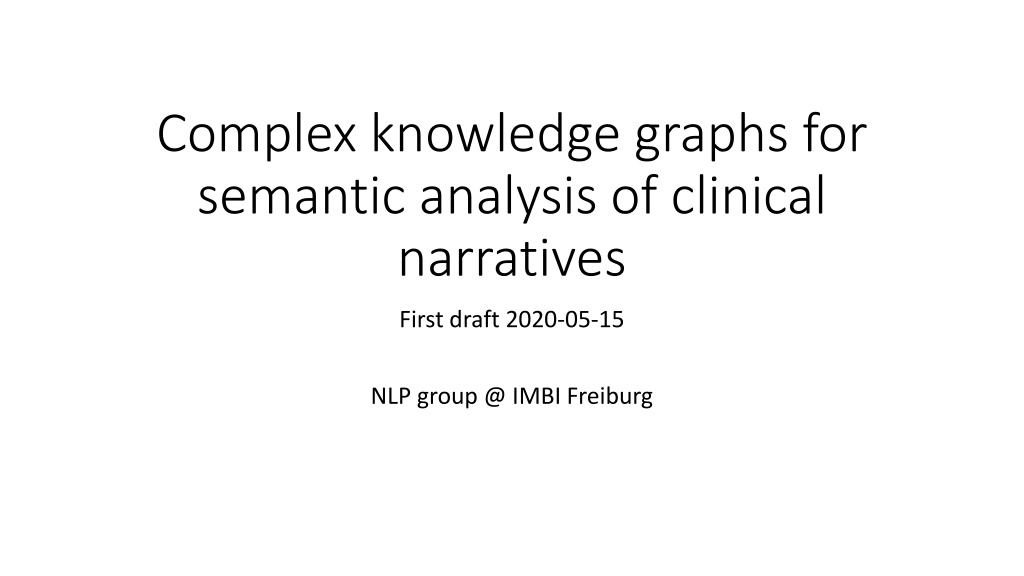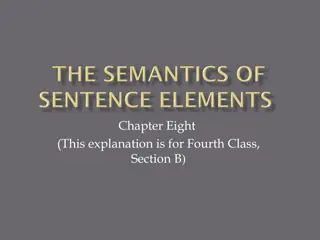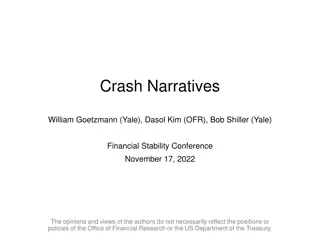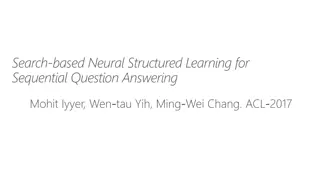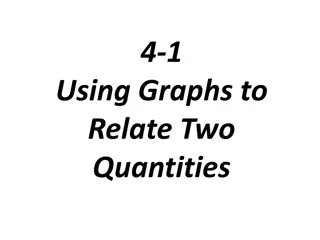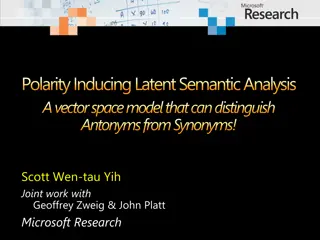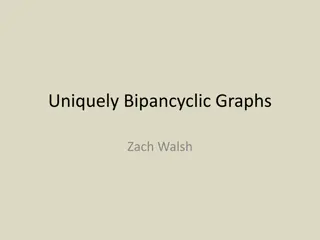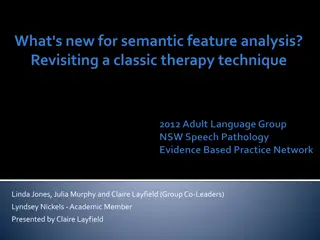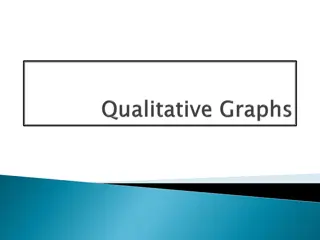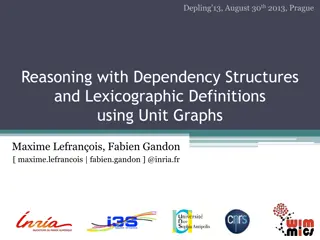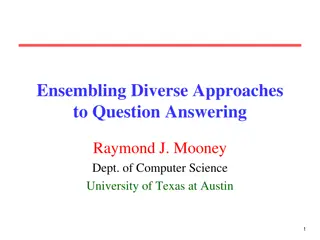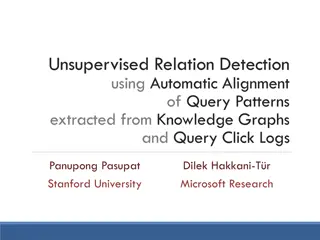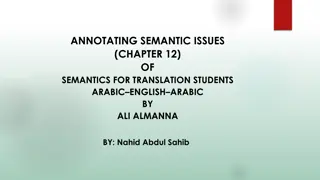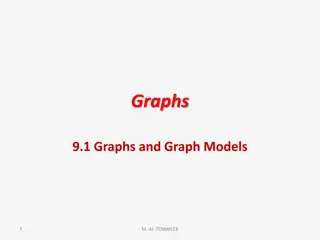Semantic Analysis of Clinical Narratives Using Complex Knowledge Graphs
Need for improved semantic analysis of clinical narratives for information retrieval and decision support is addressed through the use of complex knowledge graphs. These graphs capture axiomatic descriptions of generalizable truths about entities in the medical domain, providing a language-independent framework for understanding medical concepts and relationships. Advanced NLP tools and technologies, such as neural machine learning approaches, are employed to process vast amounts of clinical text data and enhance the ontology-based analysis. The Language Reality Ontology is a key component in structuring medical information for semantic understanding and knowledge extraction.
Download Presentation

Please find below an Image/Link to download the presentation.
The content on the website is provided AS IS for your information and personal use only. It may not be sold, licensed, or shared on other websites without obtaining consent from the author. Download presentation by click this link. If you encounter any issues during the download, it is possible that the publisher has removed the file from their server.
E N D
Presentation Transcript
Complex knowledge graphs for semantic analysis of clinical narratives First draft 2020-05-15 NLP group @ IMBI Freiburg
Background Need for improved semantic analysis of clinical narratives for Information retrieval Decision support Availability of huge amount of data Ontologies (SNOMED CT) Other clinical vocabularies Clinical texts Medicine-related publications (scientific, educational , encyclopaedical) Tools and technology NLP tools Neural machine learning approaches (embeddings, transformer-based language models)
Axiomatic descriptions of generalizable truths about entities of a domain, shared by all users of the ontology Language-independent (apart from human-understandable labels) Can be expressed as graphs In medicine: SNOMED CT with the largest coverage Examples: SCTID 51868009 Ulcer of duodenum: Class that has all individual duodenal ulcers as members SCTID 43706004 Vitamin C Class that has all individual amounts of Vitamin C as members Axioms: Every ulcer of duodenum is part of the duodenum Every amount of vitamin C is an amount of sugar acid Language Reality Ontology Everything that happens in a medical or health context, e.g. the Vitamin C tablet Mrs X took this morning or the ulcer in the duodenum of Mr. Y Normally referred to by clinical narratives, less often in structured databases, even less frequently annotated with codes (codes often just for billing, with known biases) Human language: Vocabulary and grammar used for communication. Highly specialised. Sublanguages like the medical language, with elements from several natural languages. Convergence between sublanguages of different natural languages
Language Reality Ontology link.springer.com/article/10.1007/s13244-017-0562-5 05.02.2028 GKCT-Befund: im Bereich des Pylorus und proximalen Duodenum demat se Wandverdickung -> k nnte auf ein Ulcus hinweisen
39204006 | Pyloric ulcer (disorder)| 51868009 | Ulcer of duodenum (disorder)| Language Reality Ontology 38848004 | Duodenal structure (body structure)| SubclassOf 56734009 | Structure of superior portion of duodenum (body structure)| 79654002 |Edema (morphologic abnormality)| 280119005| Pyloric structure of stomach (body structure)| 56208002 |Ulcer (morphologic abnormality)| 263899003 |Thickened (qualifier value)| 7196007 | Suggestive of (attribute)| i76897 i99854 i8800 i24356 i77163 i93404 link.springer.com/article/10.1007/s13244-017-0562-5 05.02.2028 GKCT-Befund: im Bereich des Pylorus und proximalen Duodenum demat se Wandverdickung -> k nnte auf ein Ulcus hinweisen
Associated_morphology some 56208002 |Ulcer (morphologic abnormality)| 25374005 |Gastroenteritis (disorder)| 404684003 |Clinical finding (finding)| Language Reality Ontology 79654002 |Edema (morphologic abnormality)| 263899003 |Thickened (qualifier value)| 7196007 | Suggestive of (attribute)| i99854 i8800 i98884 i77163 i09896 CT interpretation identified findings consistent with peptic gastro-duodenitis, namely oedematous mural thickening
Graph structures Ontology Multi-taxonomy of concepts by transitive is-a relation Other relations between concepts (correspond to existentially quantified OWL object properties) Reality (represented by NLP-generated ontology annotations) Sequence of ontology codes representing instantiations of the ontology (real-world objects) Some structure provided by the NLP system (e.g. scope of negation, document sections, attribute-value pairs Hidden relations between instances Interweaving of existential fact statements and predications (including uncertainty statements) (Human) Language Vocabulary linked to ontology Grammatical structures and language phenomena anaphora: "im proximalen Dudenum . Ulcus" means "im proximalen Dudenum . Ulcus des Duodenum" ellipsis: "mural thickening" means "thickening of the duodenal wall") Cross-lingual similarities Words are linked to word fragments (subwords / morphemes / n-grams) The same fragments are linked to by similar words in different natural languages ulcer ulcus ulkus er$ cer ^ul lce ulc us$ cus kus
Project ideas Purpose: Finding similar graphs Enhancing existing graphs Detect and repair weaknesses / errors in NLP output Next steps Identify major gaps of current NLP output Check state-of-the-art of Knowledge Graphs Identify interesting research question in that area and assess whether they can be used to improve medical NLP / semantic interpretation Check suitable templates for semantic text content extracts, e.g. FHIR Test suitability of methods (graph embeddings, BERT, etc.)
